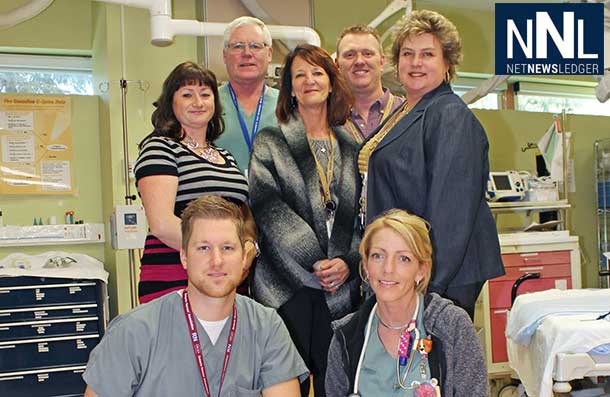

ED Nurses Trained in C-Spine Evaluation
THUNDER BAY – Health – There is nothing quite like the feeling of accomplishment when a three-year research project is completed and targets have been met. Lisa Beck, Program Director of Trauma, Critical Care & ED Services, and Kerry Posselwhite, RN Champion Clinical Nurse Specialist, are two members of the project team who certainly agree. They recently celebrated the completion of TBRHSC’s participation in the CAHO ARTIC Project—The Application of the Canadian C-Spine Rule (CCR)* by Emergency Department Nurses—and the subsequent implementation into clinical practice.
The CAHO Council selected TBRHSC to participate in the Canadian C-Spine Rule (CCR) ARTIC Research Project to implement an interprofessional care approach for adult trauma patients in the ED. The project allowed nurses to autonomously evaluate the need for c-spine immobilization using algorithms and medical directives. With the use of these evidence-based tools, nurses can independently “clear” and remove c-collars without a physician assessment. This added nursing skill is unique to only nurses that have received specialized training as part of this project. At present the vast majority of nurses across Canada do not evaluate the c-spine of trauma patients.
In November 2010, TBRHSC’s team embarked on this research project, not only with CAHO’s objectives in mind—data collection, quality improvement and movement of research evidence into practice—but also with the goal to demonstrate value to patients. Success would include reducing wait times, efficient use of resources, increased comfort and overall patient satisfaction. TBRHSC was selected as one of 12 Canadian hospitals to implement this project.
Champions played a key role in accomplishing these goals. Dr. Andrew Affleck, MD as physician champion and Mr. Posselwhite assisted with educating physicians as to reasons for participating in the study and the benefits of the project. The project allowed for the standardization of care through the coordinated use of the CCR for both nurses and physicians. Their efforts, along with the credibility of CAHO and the principal investigator being Dr. Ian Stiell in Ottawa, instilled confidence with our physicians for this initiative.
Melanie Cates, RN and Bonnie Zabirka, NP were initial project champions and trained the first 45 ED nurses. By incorporating CCR training into existing educational activities, Mr. Posselwhite was able to educate an additional 50 nurses over a three-week period. This opportunity provided the initial foundation of trained CCR nurses needed for the project and built momentum to achieve success. By the end of the project a total of 95 nurses were CCR trained (70% of ED nursing staff).
During this project a total of 712 patients were screened and assessed by nurses, and 102 patients were further evaluated to potentially have their c-collars removed. Of the 102 patients, 25% had their collars successfully removed by nurses through the use of CCR tools without the need of additional diagnostic testing.
It is the expectation that by June 2014, all ED nurses will be CCR trained which will enable more trauma patients to be screened. The direct benefit of this new standardized practice is the early removal of c-collars on eligible patients to prevent prolonged immobilization causing considerable patient discomfort. This expanded practice for nurses promotes autonomous decision-making and will reduce costs by improving patient flow and reducing the need for unnecessary diagnostic procedures. It is hopeful that results of this project will be presented in Hong Kong, and will become internationally recognized.
With such an achievement under their belts, this team has plenty to celebrate.
* The Cervical-Spine Rule permits physicians to standardize care of alert, stable trauma patients, to rapidly “clear” the cervical spine, and to be much more selective in the use of cervical-spine radiography without jeopardizing patient care.






